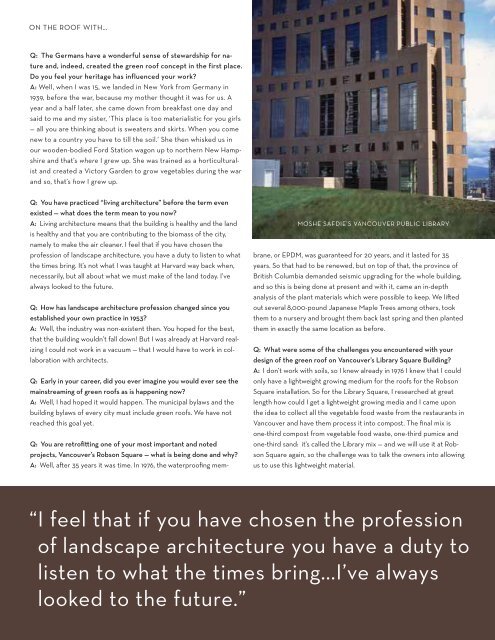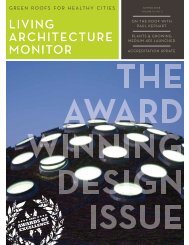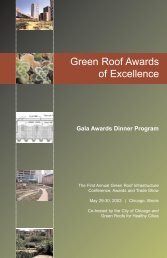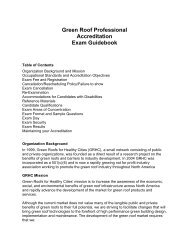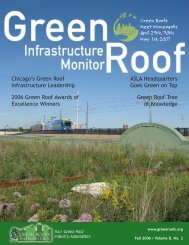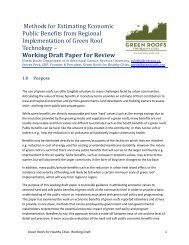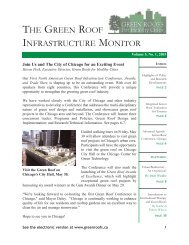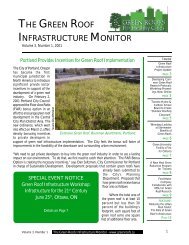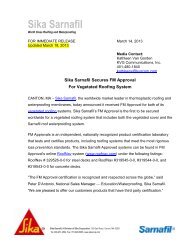Living Architecture Monitor - Green Roofs for Healthy Cities
Living Architecture Monitor - Green Roofs for Healthy Cities
Living Architecture Monitor - Green Roofs for Healthy Cities
Create successful ePaper yourself
Turn your PDF publications into a flip-book with our unique Google optimized e-Paper software.
ONTHEROOFWITH…<br />
Q: The Germans have a wonderful sense of stewardship <strong>for</strong> nature<br />
and, indeed, created the green roof concept in the first place.<br />
Do you feel your heritage has influenced your work?<br />
A: Well, when I was 15, we landed in New York from Germany in<br />
1939, be<strong>for</strong>e the war, because my mother thought it was <strong>for</strong> us. A<br />
year and a half later, she came down from breakfast one day and<br />
said to me and my sister, ‘This place is too materialistic <strong>for</strong> you girls<br />
— all you are thinking about is sweaters and skirts. When you come<br />
new to a country you have to till the soil.’ She then whisked us in<br />
our wooden-bodied Ford Station wagon up to northern New Hampshire<br />
and that’s where I grew up. She was trained as a horticulturalist<br />
and created a Victory Garden to grow vegetables during the war<br />
and so, that’s how I grew up.<br />
Q: You have practiced “living architecture” be<strong>for</strong>e the term even<br />
existed — what does the term mean to you now?<br />
A: <strong>Living</strong> architecture means that the building is healthy and the land<br />
is healthy and that you are contributing to the biomass of the city,<br />
namely to make the air cleaner. I feel that if you have chosen the<br />
profession of landscape architecture, you have a duty to listen to what<br />
the times bring. It’s not what I was taught at Harvard way back when,<br />
necessarily, but all about what we must make of the land today. I’ve<br />
always looked to the future.<br />
Q: How has landscape architecture profession changed since you<br />
established your own practice in 1953?<br />
A: Well, the industry was non-existent then. You hoped <strong>for</strong> the best,<br />
that the building wouldn’t fall down! But I was already at Harvard realizing<br />
I could not work in a vacuum — that I would have to work in collaboration<br />
with architects.<br />
Q: Early in your career, did you ever imagine you would ever see the<br />
mainstreaming of green roofs as is happening now?<br />
A: Well, I had hoped it would happen. The municipal bylaws and the<br />
building bylaws of every city must include green roofs. We have not<br />
reached this goal yet.<br />
MOSHESAFDIE’SVANCOUVERPUBLICLIBRARY<br />
Q: You are retrofitting one of your most important and noted<br />
projects, Vancouver’s Robson Square — what is being done and why?<br />
A: Well, after 35 years it was time. In 1976, the waterproofing membrane,<br />
or EPDM, was guaranteed <strong>for</strong> 20 years, and it lasted <strong>for</strong> 35<br />
years. So that had to be renewed, but on top of that, the province of<br />
British Columbia demanded seismic upgrading <strong>for</strong> the whole building,<br />
and so this is being done at present and with it, came an in-depth<br />
analysis of the plant materials which were possible to keep. We lifted<br />
out several 8,000-pound Japanese Maple Trees among others, took<br />
them to a nursery and brought them back last spring and then planted<br />
them in exactly the same location as be<strong>for</strong>e.<br />
Q: What were some of the challenges you encountered with your<br />
design of the green roof on Vancouver’s Library Square Building?<br />
A: I don’t work with soils, so I knew already in 1976 I knew that I could<br />
only have a lightweight growing medium <strong>for</strong> the roofs <strong>for</strong> the Robson<br />
Square installation. So <strong>for</strong> the Library Square, I researched at great<br />
length how could I get a lightweight growing media and I came upon<br />
the idea to collect all the vegetable food waste from the restaurants in<br />
Vancouver and have them process it into compost. The final mix is<br />
one-third compost from vegetable food waste, one-third pumice and<br />
one-third sand: it’s called the Library mix — and we will use it at Robson<br />
Square again, so the challenge was to talk the owners into allowing<br />
us to use this lightweight material.<br />
“I feel that if you have chosen the profession<br />
of landscape architecture you have a duty to<br />
listen to what the times bring...I’ve always<br />
looked to the future.”


